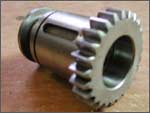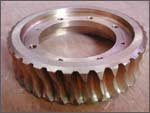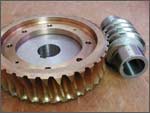Gears
Gear Boxes | ||
Spur Gear
The teeth on helical gears are cut at an angle to the face of the gear. When two teeth on a helical gear system engage, the contact starts at one end of the tooth and gradually spreads as the gears rotate, until the two teeth are in full engagement. His gradual engagement makes helical gears operate much more smoothly and quietly than spur gears. For this reason, helical gears are used in almost all car transmissions. Because of the angle of the teeth on helical gears, they create a thrust load on the gear when they mesh. Devices that use helical gears have bearings that can support this thrust load. One interesting thing about helical gears is that if the angles of the gear teeth are correct, they can be mounted on perpendicular shafts, adjusting the rotation angle by 90 degrees.
| Diameter upto 3,800 mm |
| Module = 0.40 to 30 Module |
| Ground Gear = PCD = 25 to 550 mm pitch circular diameter |
| Module = 1 to 10 Module |

Helical Gear
The teeth on helical gears are cut at an angle to the face of the gear. When two teeth on a helical gear system engage, the contact starts at one end of the tooth and gradually spreads as the gears rotate, until the two teeth are in full engagement. His gradual engagement makes helical gears operate much more smoothly and quietly than spur gears. For this reason, helical gears are used in almost all car transmissions. Because of the angle of the teeth on helical gears, they create a thrust load on the gear when they mesh. Devices that use helical gears have bearings that can support this thrust load. One interesting thing about helical gears is that if the angles of the gear teeth are correct, they can be mounted on perpendicular shafts, adjusting the rotation angle by 90 degrees.
| Diameter upto 3,800 mm |
| Module = 0.40 to 30 Module |
| Ground Gear = PCD = 25 to 550 mm pitch circular diameter |
| Module = 1 to 10 Module |

Bevel Gear
Bevel gears are useful when the direction of a shaft's rotation needs to be changed. They are usually mounted on shafts that are 90 degrees apart, but can be designed to work at other angles as well. The teeth on bevel gears can be straight, spiral or hypoid. Straight bevel gear teeth actually have the same problem as straight spur gear teeth -- as each tooth engages, it impacts the corresponding tooth all at once. just like helical teeth: the contact starts at one end of the gear and progressively spreads across the whole tooth. On straight and spiral bevel gears, the shafts must be perpendicular to each other, but they must also be in the same plane. If you were to extend the two shafts past the gears, they would intersect. The hypoid gear, on the other hand, can engage with the axes in different planes. This feature is used in many car differentials. The ring gear of the differential and the input pinion gear are both hypoid. This allows the input pinion to be mounted lower than the axis of the ring gear.
| Diameter upto 800 mm |
| Module = 20 |
| Face Width = 200 mm |

Worms & Worm Gear
Worm Gear
| Diameter upto 1500 mm |
| Module upto 20 |
| Minimum CD of Worm & Worm Wheel = 28 mm by Trangential Method. |
Worm
| Diameter upto 300 mm |
| Module = 1 to 20 |

Timer Pulley
Any standard pitch we can make.

Sprockets
Pitch = 1/8' to 3' - Face Width = 1,000 mm .

Custom Made Gear Boxes
Internal Gear
| ID = 450 mm (Dia - 600 mm) |
| Module upto 6 Module |
| Lenght = 550 mm |
| Module = 6 mm |

 |
 |
|
| SPUR PINION | SPUR GEAR | |
 |
||
| SPUR GEAR | ||
 |
: | |
| HELICAL GEAR | ||
 |
 |
|
| WORM WHEEL | WORM | |
 |
: | |
| WORM & WORM WHEEL | ||
 |
: | |
| INTERNAL RING GEAR | ||